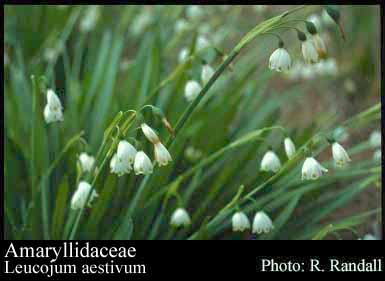- Reference
- Expos.Fam.Nat. 1:134 (1805)
- Name Status
- Current

Scientific Description
Common name. Amaryllis Family.
Family Sometimes included in Liliaceae.
Habit and leaf form. Herbs; mostly deciduous. Perennial; plants with a basal concentration of leaves, or with neither basal nor terminal concentrations of leaves; bulbaceous, or rhizomatous (in that a few have structures transitional between rhizomes and bulbs). Mesophytic. Leaves alternate; spiral, or distichous; ‘herbaceous’; sessile, or petiolate (or almost so); sheathing; simple. Leaf blades entire; linear, or lanceolate, or oblong, or ovate, or orbicular; parallel-veined; without cross-venules. Leaf blade margins entire. Leaves with a persistent basal meristem, and basipetal development. Stem anatomy. Secondary thickening absent.
Reproductive type, pollination. Fertile flowers hermaphrodite. Unisexual flowers absent. Plants hermaphrodite. Floral nectaries present. Nectar secretion from the perianth (from the inner tepals, in Galanthieae), or from the gynoecium (from septal nectaries).
Inflorescence and flower features. Flowers solitary, or aggregated in ‘inflorescences’; in cymes (variously condensed), or in umbels, or in heads. The terminal inflorescence unit cymose. Inflorescences scapiflorous; cymose, but often umbels or heads by condensation; with involucral bracts (2–8 free or connate scales), or without involucral bracts; spatheate. Flowers regular to somewhat irregular to very irregular; when irregular, somewhat zygomorphic; 3 merous; cyclic; tetracyclic, or pentacyclic. Perigone tube present (short to long), or absent. Perianth of ‘tepals’; 6; 2 -whorled (3+3, but often with a conspicuous ‘corona’, like an extra, inner whorl); isomerous; petaloid; similar in the two whorls; green, or green to white, or white, or cream, or yellow, or red, or pink, or purple, or purple and brown (not blue). Androecium (3–)6(–18) (nearly always 3+3). Androecial members free of the perianth, or adnate (to the tube); free of one another, or coherent; when joined 1 - adelphous; nearly always 2 -whorled (3+3). Androecium exclusively of fertile stamens (at least, reduction to staminodes not mentioned by Dahlgren et al. 1985). Stamens 3 (in Zephyra), or 6 (usually), or 9–18 (Gethyllis); isomerous with the perianth (rarely), or diplostemonous; (nearly always?) alterniperianthial; filantherous (the filaments sometimes appendaged alongside the anthers). Filaments appendiculate (the connate filaments sometimes expanded to form a staminal corona), or not appendiculate. Anthers dorsifixed (epipeltate), or basifixed (rarely); versatile (usually), or non-versatile; dehiscing via pores, or dehiscing via longitudinal slits; introrse (usually), or latrorse (e.g. Crinum); tetrasporangiate. Gynoecium 3 carpelled. The pistil 3 celled. Carpels isomerous with the perianth. Gynoecium syncarpous; eu-syncarpous; inferior, or partly inferior (rarely). Ovary plurilocular; 3 locular. Gynoecium stylate. Styles 1; apical. Stigmas 1, or 3; 1–3 - lobed; capitate; dry type (mostly), or wet type (some); papillate; Group II type and Group III type. Placentation axile. Ovules 12–50 per locule (i.e. ‘several to many’); non-arillate; anatropous.
Fruit and seed features. Fruit fleshy, or non-fleshy; dehiscent, or indehiscent; a capsule, or a berry. Capsules loculicidal. Seeds endospermic. Endosperm oily. Seeds winged, or wingless; without starch. Cotyledons 1. Embryo achlorophyllous (5/5), or chlorophyllous (two species of Haemanthus); straight. Testa encrusted with phytomelan, or without phytomelan. Seedling. Hypocotyl internode absent. Mesocotyl absent. Seedling collar not conspicuous. Cotyledon hyperphyll elongated, or compact; assimilatory, or non-assimilatory; dorsiventrally flattened. Coleoptile absent. First leaf dorsiventral. Primary root ephemeral.
Physiology, biochemistry. Photosynthetic pathway: C3.
Geography, cytology, number of species. Holarctic, Paleotropical, Neotropical, Cape, and Australian. World distribution: widespread. About 800 species.
Economic uses, etc. Many cultivated ornamentals.